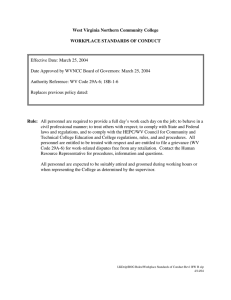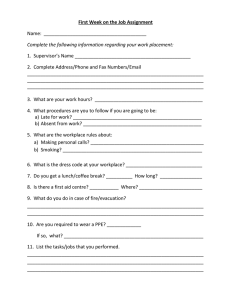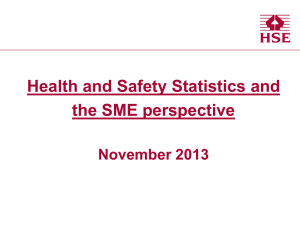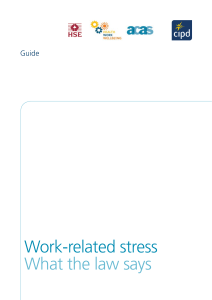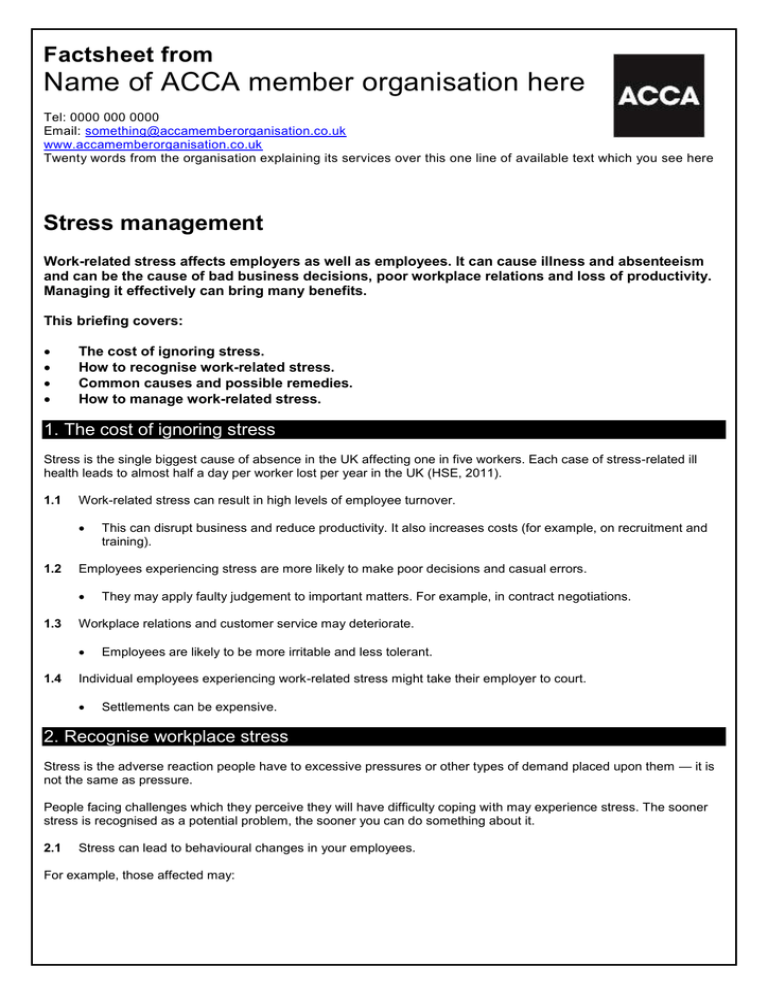
Factsheet from
Name of ACCA member organisation here
Tel: 0000 000 0000
Email: something@accamemberorganisation.co.uk
www.accamemberorganisation.co.uk
Twenty words from the organisation explaining its services over this one line of available text which you see here
Stress management
Work-related stress affects employers as well as employees. It can cause illness and absenteeism
and can be the cause of bad business decisions, poor workplace relations and loss of productivity.
Managing it effectively can bring many benefits.
This briefing covers:
The cost of ignoring stress.
How to recognise work-related stress.
Common causes and possible remedies.
How to manage work-related stress.
1. The cost of ignoring stress
Stress is the single biggest cause of absence in the UK affecting one in five workers. Each case of stress-related ill
health leads to almost half a day per worker lost per year in the UK (HSE, 2011).
1.1
Work-related stress can result in high levels of employee turnover.
1.2
Employees experiencing stress are more likely to make poor decisions and casual errors.
1.3
They may apply faulty judgement to important matters. For example, in contract negotiations.
Workplace relations and customer service may deteriorate.
1.4
This can disrupt business and reduce productivity. It also increases costs (for example, on recruitment and
training).
Employees are likely to be more irritable and less tolerant.
Individual employees experiencing work-related stress might take their employer to court.
Settlements can be expensive.
2. Recognise workplace stress
Stress is the adverse reaction people have to excessive pressures or other types of demand placed upon them — it is
not the same as pressure.
People facing challenges which they perceive they will have difficulty coping with may experience stress. The sooner
stress is recognised as a potential problem, the sooner you can do something about it.
2.1
Stress can lead to behavioural changes in your employees.
For example, those affected may:
2.2
Feel constantly rushed and unable to concentrate.
Not be able to switch off from work, or feel tired all the time.
Dread coming into work.
Lose their sense of humour and become moody and irritable.
Change the pattern of their working day (eg they might start staying late and consistently refuse to take
breaks).
Start taking more sick leave.
Drop the standard of their work.
Employees may show signs of physical illness.
For example, they may:
2.3
Complain of nausea, frequent headaches and migraines or other unexplained aches and pains.
Admit to sleeping badly.
Seem jumpy, or you may notice they are shaky or trembling.
Experiencing consistent levels of stress may lead to longer-term illnesses.
Stress has been linked to asthma, high blood pressure, heart disease, ulcers, strokes and even cancer.
It can also cause mental health problems, such as anxiety or depression.
3. Common causes
There are many factors that can result in employees experiencing workplace stress. You may need to address several
areas to remove the causes of the stress.
3.1
Demands of the job.
3.2
Long hours and reluctance to take leave.
3.3
Ineffective management can cause employees stress. For example, failure to address known problem areas
or deal with problem employees.
Periods of change.
3.6
Problems with a manager or fellow employee can be a major source of work-related stress.
Humiliating employees, or allowing others to, leads to a loss of respect and co-operation from employees.
Bullying or aggressive behaviour will certainly cause stress and can also lead to legal action.
Management style.
3.5
It may sometimes be necessary for employees to come in early and leave late. But working in excess of
normal hours for extended periods can result in accidents and mistakes.
Workplace relationships.
3.4
It is counterproductive to give employees too much to do or not enough time to complete it in on a
continuous basis.
Poor instructions or insufficient training can cause stress.
Employees may over-estimate their own capacity for work and then be reluctant to admit they have bitten off
more than they can chew.
Any change in the way a business operates can upset the working environment.
Insufficient support or information during times of change or busy periods creates uncertainty.
Organisational structure.
2
3.7
Lack of clarity about roles, responsibilities and objectives causes confusion and lack of direction.
Personal problems
Managers should not ignore employees’ personal problems.
For example, bereavement, divorce, illness, moving home and financial problems can all cause high levels of
stress that may impact on an employee's ability to carry out his or her job.
4. Tackle the causes
Taking action to manage stress effectively can have a positive effect. Employees will be more committed to your
business and productivity is likely to increase.
4.1
Introduce measures to reduce the demands of the job.
Set targets that are challenging but realistic.
Make sure employees do not take on too much work. Encourage delegation where possible.
Provide training in time management, if necessary.
Encourage employees to prioritise and tackle the most important tasks first.
4.2
Take steps to avoid a long-hours culture.
4.3
Rule by reward, not punishment. Let employees know their work is valued and appreciated.
Review performance regularly, so employees know how well they are doing.
Operate an open door policy, and encourage employees to approach you with problems.
Monitor levels of absence and sickness leave.
Survey staff to assess staff attitudes and experiences in the workplace.
Draw up a stress policy stating that you take stress seriously and detailing how you plan to deal with
workplace stress.
Offer employees training, help, advice and support.
Inform employees about changes that affect the way the company operates.
4.6
Draw up a policy to prevent bullying and harrassment.
Consider training managers in interpersonal skills.
Make sure there is someone within the company that employees can bring their problems to in confidence.
Establish a style of management that is appropriate and productive.
4.5
Encourage employees to take regular short breaks, in addition to longer holidays to allow them to unwind
fully.
Make sure they take a lunch break, rather than eating on the job.
Encourage employees to leave on time and to do something in complete contrast to their work.
Implement policies and procedures to improve working relationships.
4.4
Cut back on time-wasting activities, such as over-long meetings.
Ensure employees understand the company’s long-term goals.
Explain the reasons for any change and how they might be affected.
Arrange meetings to discuss new projects so everyone is clear what is happening and knows what is
expected of them.
Encourage two-way communication with staff. Ask for input, ideas and opinions.
Establish clear job descriptions.
3
4.7
Clarify employees’ objectives and responsibilities.
Provide support to employees experiencing personal problems and difficulties.
Offer employees time off if necessary.
Consider offering more flexible working arrangements.
If appropriate, encourage employees to seek professional help.
5. Managing workplace stress
5.1
Be aware of your legal responsibilities.
Under health and safety regulations you are responsible for the occupational health of your employees.
Implement the Health & Safety Executive management standards to ensure best practice
(www.hse.gov.uk/stress/standards/index.htm).
5.2
Conduct a stress risk assessment of your business.
5.3
Your audit should highlight actual and potential causes of stress.
It should reflect the areas of risk identified in the Health & Safety Executive's management standards (see
5.1).
The audit can be done by using questionnaires or by talking to staff, individually or in groups.
Put in place an effective stress policy and procedures for managers and employees.
A model stress policy can be found on the Health & Safety Executive website (see 6.1).
5.4
Make sure managers understand their roles and responsibilities in managing workplace stress.
5.5
Consider offering access to counselling services (see 6.5).
6. Sources of help
6.1
The Health & Safety Executive provides guidance and real-life examples of how businesses have managed
stress effectively (www.hse.gov.uk/stress).
6.2
Acas has produced a range of information on stress (www.acas.org.uk).
6.3
The Institute of Occupational Health and Safety offers a number of courses on stress (www.iosh.co.uk or 0116
257 3100).
6.4
Access qualified stress management professionals through the International Stress Management Association
(www.isma.org.uk or 07000 780 430).
6.5
One-to-one stress counselling services can be found through the Employee Assistance Professional Association
(www.eapa.org.uk or 0800 783 7616) or the British Association for Counselling and Psychotherapy
(www.bacp.co.uk or 01788 550899).
6.6
The Mental Health Foundation website has a range of free publications and links to other useful sources of
information (www.mentalhealth.org.uk).
Tough at the top
Owner managers and directors often find their positions lonely and isolating, which itself can cause stress.
A.
There is often little support in decision-making.
4
Employees often expect the boss to know exactly what to do.
B.
Decision-making is more stressful if there is no-one to share responsibility should things go wrong.
Discussing work-related or personal problems with employees may feel inappropriate, leading to further
feelings of isolation.
Try finding ways to talk.
Create an informal group of colleagues who work at the same level in other companies.
They will probably be just as keen to discuss their challenges at work as you.
C.
Consider bringing in outside help.
A mentor (or executive coach) could help you cope with the pressures of running a business.
The NHS Health for Work Adviceline in England is free and offers small firms ways to address the issue
of employee health, minimise the impact of staff illness, and pro vide essential support to staff with
physical or mental health issues. Tel: 08000 778 844.
The Health & Safety Executive publishes a free guide called ‘Work-related stress’ (01787 881165 or
www.hse.gov.uk/pubns).
Experts’ quotes
“Taking action to manage work-related stress effectively will bring dividends to all.”
Caroline Raymond,
Stress in Perspective Ltd
Expert contributors
Thanks to Caroline Raymond (Stress In Perspective Ltd, 01747 811071; enquiries@stress-ip.co.uk; www.stressip.co.uk)
Last updated 01.12.11
© BHP Information Solutions 2011. ISSN 1369-1996. All rights reserved. No part of this publication may be reproduced or transmitted without the
written permission of the publisher. This publication is for general guidance only. The publisher, expert contributors and distributor disclaim all liability
for any errors or omissions. Consult your local business support organisation or your professional adviser for help and advice.
5


